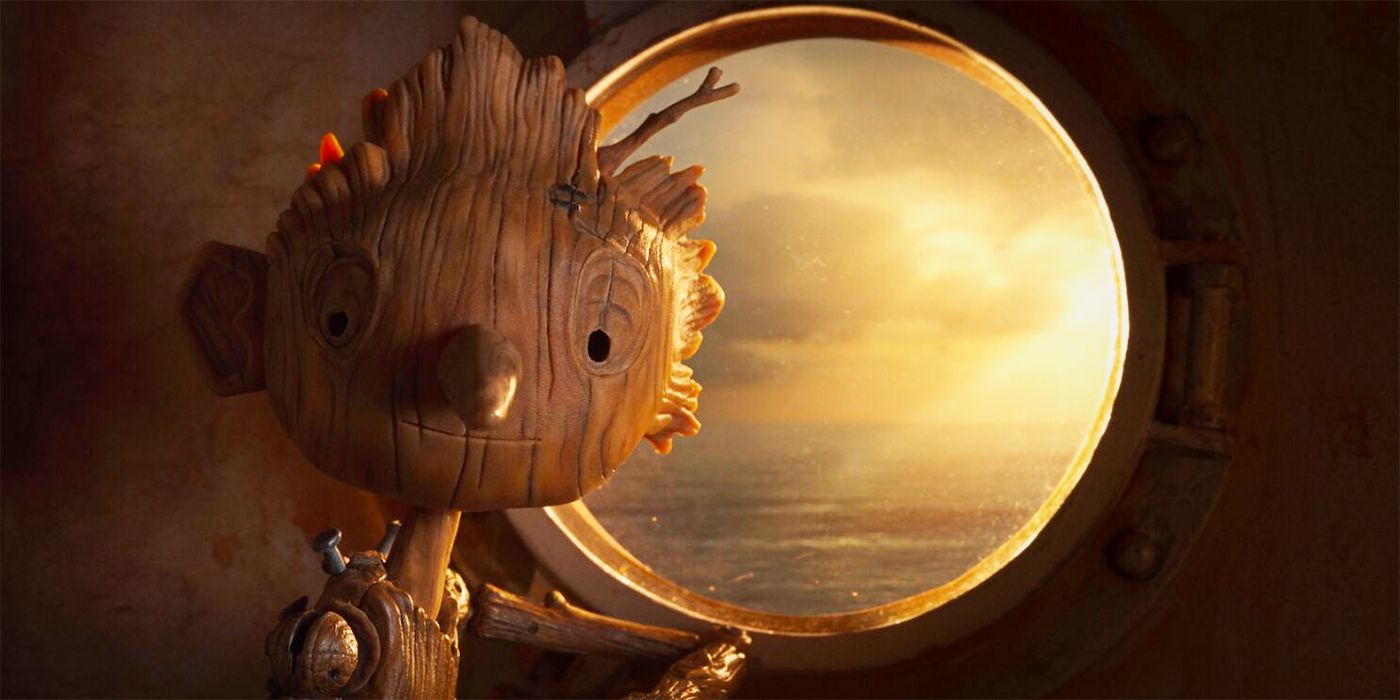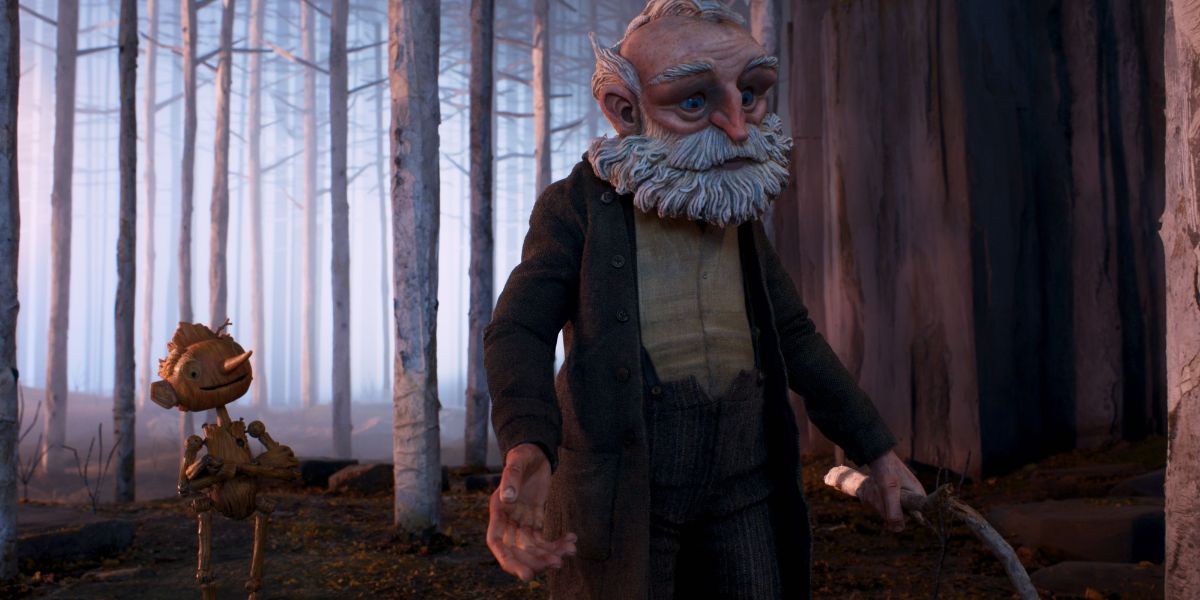Guillermo del Toro has spent awards season championing not his film, Guillermo del Toro’s Pinocchio, but the medium of animation as a whole. He consistently championed animation and the means of storytelling it can produce — and the film world listened, awarding del Toro's Pinocchio for its music and its craft. On Oscar nomination morning, it received a nomination for Best Animated Feature. That honor is deserved, but it feels like not enough. Animation as a whole deserves more love for animators — del Toro’s Pinocchio could have helped skyrocket the industry’s support, and yet, it still only garnered just one nomination this year.
Music in 'Guillermo del Toro's Pinocchio'
It was both a surprise and a disappointment when the Academy did not recognize Pinocchio in both the Original Score and Original Song categories, if not simply for their importance in the musical. Pinocchio (Gregory Mann) as a character uses music to express himself multiple times in the film; he shows his joy in simply existing in “Everything Is New to Me” and his longing to both remember and support Geppetto (David Bradley) with “Ciao Papa” — the song shortlisted by the Academy. Composer Alexandre Desplat is credited as a songwriter, namely for his compositions. His music is emotional, with the beautiful “Carlo’s Theme” reappearing throughout Pinocchio in different ways and also adding large, soaring numbers like “We Were a King Once” and the intense, march-like “The Late Lamented.” The music throughout Pinocchio is varied and crucial.
Desplat won the Oscar for Best Original Score in 2018 for a previous del Toro fairy tale, The Shape of Water (which also one Best Picture that year). Both the scores for Pinocchio and The Shape of Water sway between the fantastical and the dark to reflect the stories they tell. Desplat was also nominated for his scores in stop-motion animation films Wes Anderson’s Fantastic Mr. Fox and Isle of Dogs — another example of Desplat's history of creating soaring original scores worthy of nominations. And yet, Pinocchio got zilch.
'Guillermo del Toro's Pinocchio's Visuals/Production Design
Director Mark Gustafson said one animator spent two years shooting sequences of Geppetto putting Carlo and Pinocchio to bed. One can imagine all the time it took to put together the rest of the film — from when the sea monster chases them, to when Pinocchio meets the sprite of Death, to the first time when the wood sprite initially brings Pinocchio to life. From dealing with water to changes in lighting, these animators worked so hard to make a new visual language for a familiar story. Even just down to the design of Pinocchio himself — making him appear more wooden and tree-like, yet moving and so full of joy and life, is a remarkable job in itself in this field.
Now, no animated film has ever been nominated for Production Design, which is a shame. So much time and work goes into making animation, not just stop-motion. The work it takes to design a landscape and make it look magical deserves more recognition. There is some precedent for animation in Visual Effects, though. Two stop-motion films, The Nightmare Before Christmas and Kubo and the Two Strings, were nominated in this category. Both stop-motion films were recognized for their mastery (and, in the case of Nightmare, recognizing the film’s craft before Best Animated Feature existed). So, Pinocchio could have received more acknowledgment, and it did not.
'Guillermo del Toro's Pinocchio's Screenplay
Best Adapted Screenplay may have been the biggest long shot for Pinocchio. Just as their adaptation had to be visually unique, del Toro and fellow screenwriters Patrick McHale and Matthew Robbins had a tough task adapting a story that has been told many times in many different mediums — including an adventure in outer space. The story itself goes off in many directions, including turning children into donkeys. They took the roots of the story, placed it in 1930 Fascist Italy, and created a moving allegory about valuing life and kindness over capital and power.
In terms of the Adapted Screenplay category, sadly, only two animated films have been nominated here — Shrek and Toy Story 3. Original screenplay has some more history, albeit mostly from Pixar. Toy Story, Finding Nemo, The Incredibles, Ratatouille, WALL-E, Up, and Inside Out all scored nominations in this category. Significantly, no stop-motion animated films have ever been nominated for screenplay. And all films recognized are made with computer animation with only one, Shrek, not coming from Pixar. That is not an indictment on the quality of film animation or Guillermo del Toro’s Pinocchio; it’s on the Academy and the Writer’s Guild Awards and nearly every awards body for not taking animated films seriously. One body — the USC Scripter Awards — did recognize Pinocchio’s screenplay with a nomination this year, so at least the writers have that.
That is where the snubs hurt the most for Guillermo del Toro’s Pinocchio. The film is beautifully crafted and gave the Academy an easy chance to show that they can recognize the beauty in animated films as films and not just a separate category. Multiple films this year — namely Puss in Boots: The Last Wish, Marcel the Shell with Shoes On, Turning Red, Wendell and Wild, and The House — pushed film to new heights across the board, along with Pinocchio and deserved broader support. del Toro has set aside time in nearly every speech he’s made to say “animation is cinema,” and for animators and writers to be treated on the same playing field as live-action motion pictures. Instead, the Academy continues to show they still are not ready.



